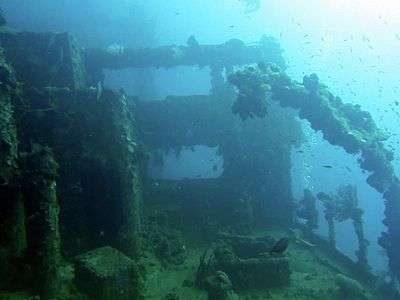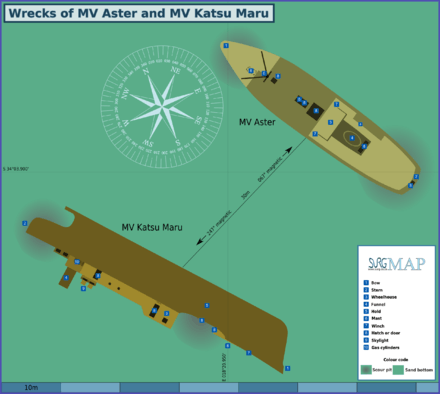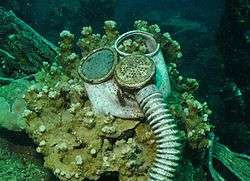Wreck diving
Wreck diving is a specific type of scuba diving. Most wreck diving is done on shipwrecks, but wrecks of aircraft are also commonly explored by scuba divers. There are also a lesser number of more exotic wrecks which are dived upon, ranging from trains and buses to collapsed naval radar stations.

All scuba divers require some form of training, but many divers engage in additional training before diving on wrecks. Wreck diving is often subdivided into three types:
- non-penetration, ie. swimming over and around the wreck.
- limited penetration, going into an overhead environment, subject to a limit of 130 feet/40 meters cumulative linear distance to surface (ie. depth plus length of penetration).
- full penetration, going deeper into the overhead environment in the wreck.
Non-penetration diving can usually be undertaken safely by most certified scuba divers. Divers are often recommended to undertake additional training, such as a wreck diver specialty course, before engaging in limited penetration diving. Full penetration diving is regarded as a type of technical diving, which requires significant additional experience, training and equipment.
Destinations
Almost every scuba diving destination in the world offers some form of wreck diving. For many areas this is as an alternative to diving on coral and other reefs; in other areas, the wrecks are the only diving attraction.
Scuba diving publications frequently print articles about "the top 10 wreck dives in the world", and broadly speaking the 10 wrecks in any particular article tend to be drawn from the following list:
- Bianca C, sunk in 1961 off Grenada in the Caribbean.
- Blackjack B17, a Flying Fortress bomber which crashed off Milne Bay, Papua New Guinea.
- Captain Keith Tibbetts, a Russian destroyer sunk as an artificial reef off Cayman Brac, Cayman Islands.
- Fujikawa Maru, probably the best of the many excellent World War Two shipwrecks in Truk Lagoon. Some argue that the 10 best diving wrecks in the world should be filled exclusively by the Truk Lagoon wrecks.
- SMS Markgraf, a German warship from World War I, probably the best of many German warships scuttled in Scapa Flow, Scotland. Some argue that the SMS Koln is the best wreck in the anchorage.
- Nagato, a Japanese World War II battleship which was sunk in Bikini Atoll, Marshall Islands as part of the nuclear tests ( closed to divers). Other divers argue that the aircraft carrier USS Saratoga is the lagoon's star attraction.
- USS Oriskany, a US aircraft carrier deliberately sunk as an artificial reef off Pensacola, Florida.
- SS President Coolidge off Vanuatu.
- SS Thislegorm, a British World War II shipwreck sunk by a mine off Sharm el-Sheikh, Egypt in the Red Sea.
- Umbria, a World War II shipwreck scuttled off Port Sudan, Sudan.
- SS Yongala, sunk in a cyclone in 1911 off coast of Ayr, Australia.
- MS Zenobia, a roll-on roll-off ferry which sunk off Larnaca, Cyprus.
The writers of these articles may have a rather limited knowledge of wrecks they have not visited, and that in journalism "top" is often equated with most popular, easily accessible, and near a resort owned by one of their advertising clients.

However there are a huge number of other very popular wreck dives elsewhere in the world, including:
Regional articles which include wreck diving sites:
- Scuba diving in Australia
- Scuba diving in the British Virgin Islands
- Diving the Cape Peninsula and False Bay, Cape Town, South Africa
- Diving in Durban, South Africa
- Diving in Port Elizabeth, South Africa
- Dive sites of Saipan, Micronesia
- Diving in Sweden
Isolated wreck site articles:
Learn
In addition to basic scuba diving certification, many people intending to dive on wrecks seek further training, both for their own safety, and also to increase their enjoyment.
Specialty courses
Many recreational diver training organisations offer wreck diving 'speciality' courses, as a supplement to basic training. According to statistics from PADI (the largest diver training organisation in the world), wreck diving is their single most popular speciality diving course.
Wreck diving speciality courses focus on the particular hazards presented by wrecks, and introduce divers to basic reel handling skills to enable them to engage in safer penetrations into the wreck. Most agencies impose a limit on recreational divers of a cumulative distance of 130 feet/40 meters of combined depth plus penetration.
Also bear in mind that shallower wrecks tend to get broken up by the elements much more quickly. Accordingly, the better preserved shipwrecks tend to be deeper. Many divers who engage in wreck diving undertake further training in deep diving as well.
Technical courses
Divers who wish to engage in more extensive penetrations usually undertake specialist technical diver training. Two of the best known technical wreck diving courses are the Advanced Wreck Diver course from TDI (the largest technical diver training organisation in the world), and the Wreck Penetration Diver course from NAUI.
Certification agencies
Recognised recreational certification agencies include:
- ACUC: The American Canadian Underwater Certifications
- ANDI: American Nitrox Divers International,
- BSAC: The British Sub Aqua Club bases its training on a network of affiliated clubs.
- CMAS: The French-based Confédération Mondiale des Activités Subaquatiques, a volunteer-run amateur organisation.
- GUE: Global Underwater Explorers concentrates on technical and cave diving specialities.
- IANTD: International Association of Nitrox Technical Divers.
- IDEA: The International Diving Educators Association
- ISI: The Independent Scuba Instructors
- NAPI: The National Association of Professional Instructors, does not train directly, but issues certification based on recognition of prior learning and experience.
- NAUI: The National Association of Underwater Instructors, US-based, is the oldest recreational scuba certification agency.
- PADI: The Professional Association of Diving Instructors, the largest scuba certification agency, a commercial agency targeted towards recreational divers who want to learn quickly.
- PDIC: The Professional Diving Instructors Corporation
- SDI/TDI: The Scuba Divers International/Technical Divers International , a certification agency designed to train with an emphasis on practical diving skills. SDI focuses on the recreational side of scuba diving and TDI is the mother branch that specializes in Technical Diving.
- SSI: Scuba Schools International, another large commercial agency.
Get in
For a general synopsis of this topic, see the relevant subsections under Scuba diving - Get in and the national and regional dive guide articles. A general listing of national dive guide articles can be found under Scuba diving — Destinations, and some of these will list regional dive guide articles in their destination sections.
Do
Wreck diving is an attractive activity for scuba divers for several different reasons:
- Marine life, wrecks are artificial reefs, which create a habitat for marine life and often attract both smaller residents and larger predators. Many famous shipwrecks are also marine parks, which helps preserve the abundant marine life.
- Artefacts, many wrecks contain cargo or machinery, which is not normally closely observable on working, floating vessels. For example, many wartime wrecks contain military cargoes such as torpedoes or gas masks. Older wrecks may employ older equipment, such as telegraphs, not commonly seen on more modern ships.
- History, although some wrecks were deliberately sunk as dive sites, many wrecks have a tragic or poignant history to their sinking. It is sometimes said that behind every great wreck dive is a great shipwreck story.
- Photography, wrecks provide a dramatic backdrop for underwater photographers. They also have the singular advantage that, unlike less predictable marine life, wrecks generally sit still for the photographer.
- Mystery, almost everyone has seen films such as The Deep, Fool's Gold and Into the Blue, in which lost treasure is found on a shipwreck. Although very few wrecks contain actual treasure, almost all underwater wrecks still possess that alluring quality of mystery.
Buy
In addition to conventional scuba diving equipment, wreck divers will normally carry additional items of kit.
- Reels, to link themselves to the point of entry whilst penetrating.
- Lights, at least one, and as many as three or four depending upon the level of penetration.
- Knife/cutting tool, conscious of their higher entanglement risk, many wreck divers carry additional cutting tools, either a knife, or shears, line cutter, or Z-blade.
- Long hoses, in the event that divers are required to share air in a restricted environment, a conventional alternate second stage on a diving regulator would be impractical.
Wreck divers also try to configure their kit so as to minimise "danglies", or any item of kit which might snag on the wreck, or any monofilament which may be lying around on the wreck. When penetrating a shipwreck, all equipment should be clipped in and secured close to the diver's body to stay streamlined. The clips used should be of a type which can not accidentally clip onto a line (those are known as suicide clips by cave divers), or should be weak enough to be broken free if they get snagged.
Stay safe
In addition to general safety advice relating to diving (as to which, see Scuba diving - stay safe) wreck divers face a number of hazards in addition to those present in conventional scuba diving. Overhead environments may prevent direct access to the surface. Sharp edges may be present on the wreck. Some wartime shipwrecks may contain explosive cargos, and some wrecks may contain toxic materials or pollutants. Wrecks are also a magnet for fisherman, due to the fish that often gather on them, and fishing line and nets may become snagged on the wreck and present an entanglement risk for divers.
Most wrecks are slowly disintegrating. The structure becomes weaker as the material corrodes or rots, and at some stage it will collapse. This is not a good time to be inside. Those wrecks which are exposed to rough sea conditions will generally deteriorate faster, but oddly enough, are also usually less of a risk for collapsing on divers, as this usually happens during a storm when no divers are around. The wrecks that are below the wave action are the ones which are more likely to collapse without warning, possibly when an unlucky diver bumps againat a critically weakened structure, and precipitates a collapse. This is very unusual, but remains a possibility, and is one of the reasons why divers should be adequately trained before attempting penetrations — it helps if you can recognise some of the signs of impending structural failure.
In conditions of poor visibility it is possible to accidentally penetrate some wrecks. If you are lucky, you will also accidentally find your way out again. If you are suitably skilled, you may also find your way out. When diving at a site where this is a possibility, it is prudent to tow a surface marker buoy on a line, or tie off a line at a point known to be outside the wreck before venturing too close in the darkness. Your line is the only guarantee of a way out.
Basic safety precautions
All diving involving overhead environments is inherently more risky. Cave divers are taught the following mnemonic in relation to ways in which the risks can be minimised: The Good Divers Are Living (or sometimes: The Good Divers Always Live).
- T - stands for Training. Don't do the dives if you don't have the training. Experience is not always an adequate substitute — you may have been lucky so far. Adequate training gives you the skills you hope to never need.
- G - stands for Guidelines. By laying a guideline you can find your way out if your lights fail, or silt reduces visibility to zero. In some cases where the wreck lies on its side or upside down, the route may simply be confusing, and it is very embarrassing to forget the way out, even if you finally work it out.
- D - stands for Depth. Deeper waters means more nitrogen narcosis - divers need to have their wits about them inside high risk environments. Stay within your limits. Use Helium based gases for deeper dives if you can. They are more expensive and require extra training, but they improve the dive experience, as you remain more aware of what is happenning around you, and remember the dive much better when not narked.
- A - stands for Air supply. Divers should always turn back at or before they hit two thirds of their original gas supply. One third is to go in, one third to get back out, and one third for your buddy in case of loss of gas emergencies. For full penetrations consider carrying a fully independent bailout gas supply.
- L - stands for Lights. If you are penetrating beyond the zone where surface light can reach, divers are trained to carry at least three battery operated lights. It is no fun to be stuck in the middle of a shipwreck unable to see with a diminishing air reserve, though if properly trained, and using a guideline, it should not be a big problem to find your way out. The line is more important for safety than the lights, but the light will make you much happier at the time.
Respect

Many popular diving wrecks have suffered over the years due to the depredations of souvenir hunting divers. In the past, many areas have had a culture of artefact removal from wrecks, but there has been far greater emphasis on preserving the historical nature of the wrecks. Many countries now impose stiff criminal penalties on divers who remove artefacts. Other wrecks have suffered over the years due to heavy usage by divers and the resultant accidental impacts.
Although increasingly less common, some wrecks which attract divers still contain human remains. Divers are well advised to respect the last resting place of the people who perished when the vessel sank.
Divers should strive to abide by the following basic guidelines when on wrecks:
- Look but don't touch, nature will eventually grind each shipwreck away into rust - there is no need to accelerate the process. Besides, a scrape from a rusty metal wreck can be nasty.
- Don't take souvenirs, everything you take is one less thing for future divers to look at, and often one less home for sea creatures. This is also illegal in some areas in the case of both protected marine sanctuaries and wrecks.
- Learn good buoyancy control, so that you can avoid accidental damage to the site from crashing into things. It will also help you avoid accidental damage to yourself or stirring up silt if you penetrate inside the wreck.
Some dive organisations promote a diving variant of the leave no trace motto: "take nothing but photographs, leave nothing but bubbles."
Specific guidance to local wreck legislation may be found in some of the national dive guide articles: